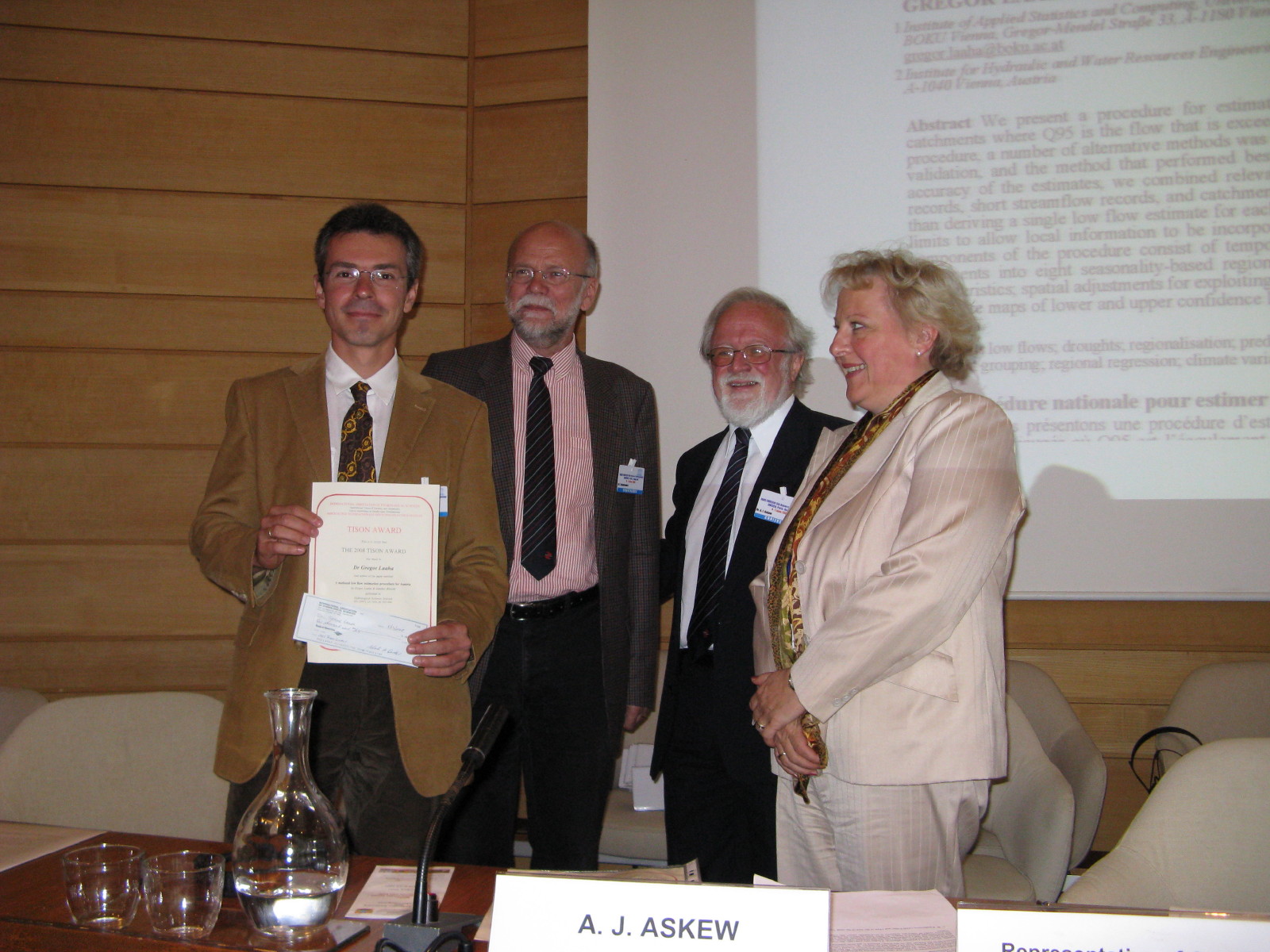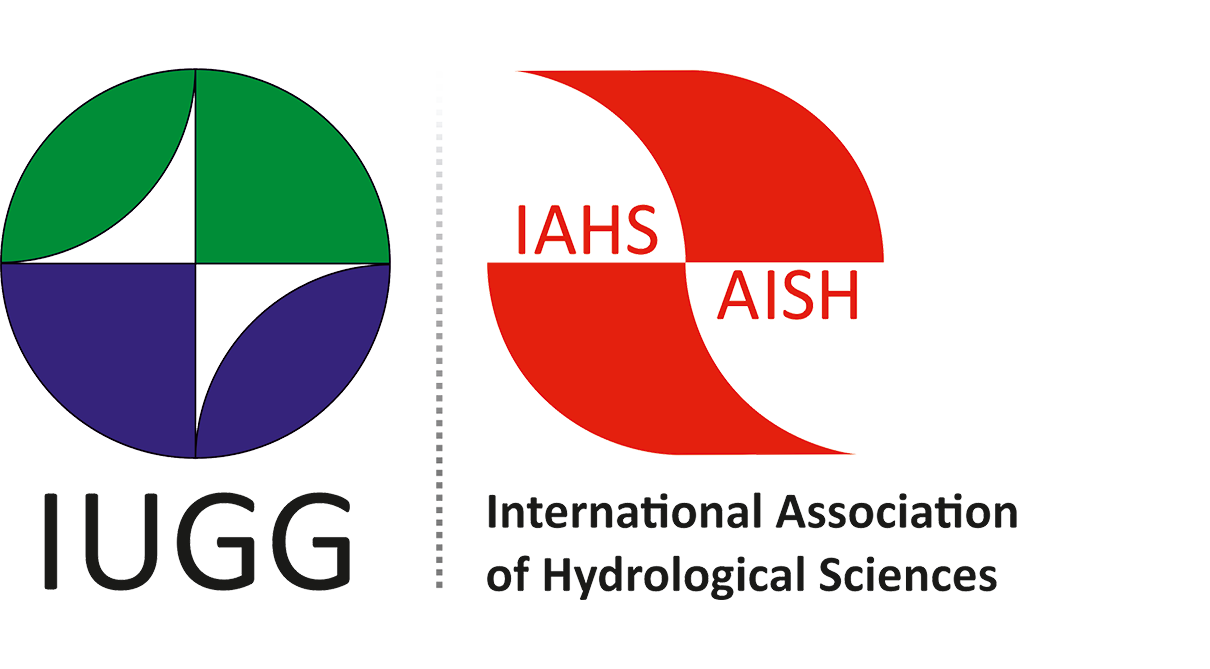Tison Award 2008 / Prix Tison 2008
The 2008 Tison Award has been granted to Gregor Laaha from Austria for his paper
A national low flow estimation procedure for Austria
co-authored by Günter Blöschl and published in Hydrological Sciences Journal in August 2007.

The presentation of the 2008 Tison Award to Gregor Laaha took place in Paris at the end of the IXth Kovacs Colloquium on Saturday 7 June 2007.
From left to rigth : Gregor Laha, Z. Kundzewicz - IAHS Editor, A. Askew - IAHS President, Ms Helene Steinhäusl - Minister, Deputy Permanent Delegate of Austria within UNESCO
Citation by Z.W. Kundzewicz, IAJHS Editor, Chairman of the Tison Award Jury
The Jury of the 2008 Tison Award: Dr Z. W. Kundzewicz (Chair, IAHS Editor), Dr Hafzullah Aksoy, Dr Berit Arheimer, Dr Jim Bogen, Dr Paul A. Hsieh, Dr John Pomeroy, and Dr H. H. G. Savenije recommended bestowing the 2008 Tison Award upon Dr Gregor Laaha, from the Institute of Applied Statistics and Computing, University of Natural Resources and Applied Life Sciences in Vienna (Austria). The winning paper: A national low flow estimation procedure for Austria, jointly authored by Dr Gregor Laaha and Dr GŸnter Blšschl was published in the Hydrological Sciences Journal (volume 52, issue 4, pages 625-644) in August 2007. The second co-author is not eligible for the Tison Award, in view of his age, as the Award is only made to younger (<41) authors.
Austria is an Alpine country, and the Alps constitute a water tower of Europe. Destructive floods in Austria, such as the summer 2002 deluge, are well known to the international community, but droughts (in the sense of meteorological droughts and hydrological droughts, including streamflow droughts and low flows) do also happen and cause material losses, so that improved understanding of processes and better estimates of low flow characteristics are important for water resources management. Even if AustriaÕs area is not very large, its landscapes are highly diverse and the low flow maps are very heterogeneous.
In the paper selected by the Jury for the 2008 Tison Award a procedure for estimating Q95 low flows in both gauged and ungauged catchments was presented, using a number of alternative methods. A comprehensive Austrian national data set was used and intercomparison of alternative methods was carried out. Different sources of information were considered, including streamflow records and characteristics of drainage basins. Rather than providing Q95 estimate, lower and upper confidence bounds were determined.
The scope and complexity of this work is significantly greater than those of the other papers nominated for the 2008 Tison Award. The national procedure for estimating low flow must be applicable to 21,000 sub-catchments with diverse climatic and physiographic characteristics and having differing amounts of streamflow records. The authors have done an excellent and thorough job in developing a practical, coherent and well-reasoned estimation strategy. They did not simply pick one estimation method, but instead evaluated a number of alternative methods by cross-validation and then chose the method with the smallest cross-validation error. The result of this research is highly valuable for water resources management. This paper is an excellent example of the high impact of scientific work on society.
The paper contains maps of the lower and upper confidence limits of low river flows (exceeded 95% of the time) for an impressive number of 21Ê000 sub-catchments in Austria. The map can obviously be used for determination of low flow characteristics over ungauged sites in Austria, hence this work constitutes a contribution to the Hydrological Atlas of Austria.
The paper follows a pragmatic stance, trying to draw the most of the relevant, information available in a particular case. It has to cope not only with sites with long river flow records, but also with sites with short records, andr those without records at all. As such, the awarded paper is a contribution to the PUB initiative, making a small, but hopefully useful, step in the direction of prediction in ungauged basins. Estimation of hydrological process characteristics in ungauged basins is one of the major problems facing water resources management in both developed and developing countries. The problems caused by climate and land use changes stress the importance of water resources assessment.
This is an interesting and innovative paper. The authors follow a thoughtful, tailored, approach, rather than blindly following the ãone-size-fits-allÓ stance. Methodology of the awarded paper includes making adjustments for short records, grouping catchments according to seasonality, regional regression of low flows with catchment characteristics, spatial adjustments for exploiting local streamflow data, and uncertainty assessments. Where no streamflow data is available, regional regression model is used.
The paper is a logical continuation of the good work done by the authors over the last years and documented by many high-quality publications. The awarded paper is a result of cooperation of scientists representing two universities in Vienna, Austria.
Dr Laaha has been known in IAHS and other international hydrological organizations, such as the EGU, for quite some time, for his publications and presentations. He has attended several IAHS assemblies and symposia. As editor of Hydrological Sciences Journal I am looking forward to receive further fine papers from Dr Laaha and co-authors. We receive more and more submissions to the Journal, but we are always pleased to get more material of highest quality.
Finally, let me share a personal reflection. Twenty-one years ago, the Tison Award was given for the first time. I am proud to say that I was the first laureate. This Prize, whose monetary value is only symbolic, has had a considerable impact on my scientific career. Ladies and Gentlemen, I feel honoured and pleased to bestow the 2007 Tison Award to Dr Gregor Laaha. Let me wish that this Prize marks an important milestone in his scientific career. My congratulations and best wishes.
Z. W. Kundzewicz, IAHS Editor and Chair of the Jury of the 2008 Tison Award
Response by Gregor Laha
Thank you very much Dr Kundzewicz. I'm much honoured by this award and to have my name added to such a list of distinguished colleagues. The awarded paper is on the topic of statistical modelling of low flow and drought, which has been in the centre of my research for the past ten years. When I started this work, the public interest on the "low" hydrological extreme was rather weak, especially in a water abundant country such as Austria (Dr. Kundzewicz called it tellingly a "water tower"). There were only few examples of bigger low flow studies in Europe at that time, notably the precious works of Alan Gustard in the UK and Siegfried Demuth in South-West Germany, and I am very greatful for their support. It was Franz Nobilis, former head of the Austrian Hydrological Service, who had the prospective idea to start a low flow regionalisation study in Austria, and I want to thank him for this main impetus to my work.
The year 2003 and subsequent years have pointed out that European societies are more vulnerable to droughts than expected. We now know that the damages of the 2003 drought which has effected most parts of Europe were of the same order of magnitude (or even higher) than the damages of the 2002 flood, and this is also true for the "water tower" Austria. Mediterranean countries, notably Spain, actually suffer increasingly from water scarcity, partially caused by unusual dry conditions during the past years, and there are many further examples for possible changes of hydro-climatological conditions across Europe. For these reasons, low flows and droughts are now a very actual reasearch field, and more and more a topic of public interest.
There are two initiatives which have done incredibly precious work in promoting drought research on an international scale and on the European scale. The first initiative is the UNESCO - FRIEND program, a cross-cutting program of the IHP. I want to thank all members of the NE-FRIEND low flow group for providing such a valuable forum of low flow and drought research. I am especially greatful to Lena Tallaksen, University of Oslo, who co-ordinated the group for the last decade, for her kind support (she is also a former winner of the Tison award, it was in 1998). The second initiative is the European Drought Center, a virtual centre of European drought research and drought management organisations to promote collaboration and capacity building between scientists and the user community. The precious work of both institutions shall be acknowledged.
My work on statistical low flow regionalisation would have been impossible without two persons, Günter Blöschl and Harald Strelec. Günter Blöschl, who is the co-author of the awarded paper, guided my work during the past ten years. He has been a fantastic mentor who initiated me in the world of hydrological regionalisation. I am greatful for his support and for our cooperation during the past decade, and I am looking forward to continuing this very fruitful cooperation in the future. I will always be greatful to the laid Prof. Strelec, former head of Institute of Applied Statistics at the BOKU Vienna University, for his support to my work. I thank him for many critical comments which helped to improve the work, and for his continuous and amicable support.
Many thanks to my family, my wife Sabine, my children Maya and Boris, and the grand-parents for helping out with the children. Finally, I want to thank the jury for this honour, and the International Association of Hydrological Sciences for being what it is.
